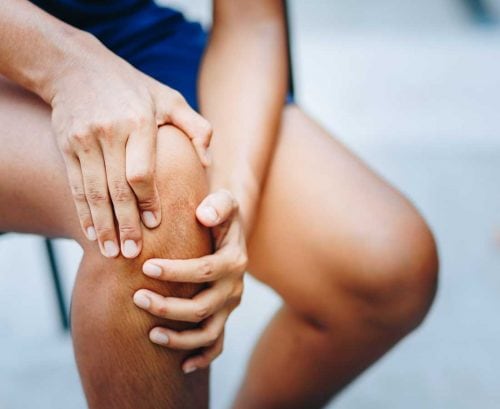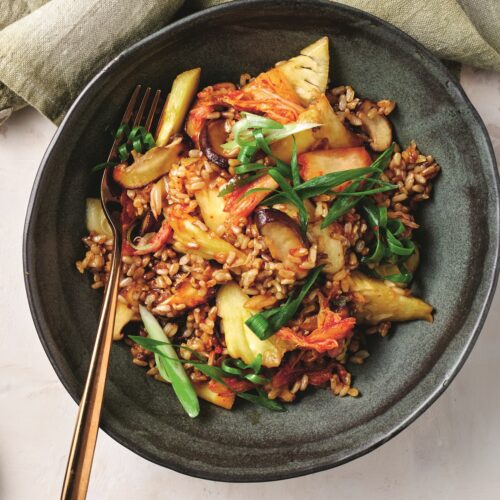
Feeling stiff in the knees? Fed up with an aching back? HFG dietitian Melissa Meier has seven science-backed ways to keep your joints healthy.
With life so busy, it’s tempting to skip your usual exercises or lose focus when it comes to eating well. If you suffer from arthritis, though, physical inactivity and a poor diet can exacerbate your symptoms — so it’s best to keep on top of healthy lifestyle habits all year. Here’s how you can keep your joints healthy — for life.
1 Get moving!
Regular exercise is extremely beneficial for people with arthritis. It can help to relieve joint stiffness, reduce pain and fight feelings of fatigue. Low-impact or water-based exercises, like bike riding or swimming, are a good option, as they help to maintain range of motion and also take the pressure off joints. Arthritis Australia highly recommends strength training, because building muscle can provide support to joints, reduce joint stress and improve mobility.
If you don’t have arthritis, some weight-bearing exercises like walking or tennis can help prevent osteoarthritis, as they help thicken joint cartilage and preserve joint lubrication.
2 Try Tai chi
Experts recommend Tai chi as an effective way to ease pain and stiffness for people with arthritis. A recent review of the scientific literature concluded there is strong evidence showing that tai chi is beneficial for osteoarthritis. As a form of gentle exercise, Tai chi involves a series of slow movements accompanied by deep breathing.
3 Protect your joints
Joints affected by arthritis are usually weaker and easier to damage, so it’s wise to take a few extra measures to protect them.
- Listen to pain When you feel something twinge, your body is telling you to stop.
- Use the largest, strongest muscles for all movements For example, engage your legs when you lift a heavy object, rather than your back.
- Focus on posture Sit and stand upright, rather than slouching. Take regular breaks from long periods in the same position.
- Avoid repetition Doing the same movement over and over can strain your joints.
- Take it easy Use a shopping trolley, rather than carrying a heavy basket or bags.
4 Managing your weight
Being overweight places extra pressure on your joints, particularly your hips, knees, feet and spine — so achieving a healthy weight is an effective approach to pain relief. Losing as little as 5 per cent of your body weight can reduce the load on your joints. In fact, for every 0.5kg lost, there is almost 2kg less pressure placed on each knee.
Losing weight, if you’re overweight, also makes it easier to move around. People who have arthritis also have a greater risk of cardiovascular disease, so losing excess weight can help to minimise this risk. For those without arthritis, a healthy weight reduces the risk of developing osteoarthritis.
5 Stop smoking
Smoking doubles your risk of joint disease, according to the Australian Medical Association. It also promotes inflammation and can contribute to joint pain. If you suffer from rheumatoid arthritis in particular, quitting smoking is a very wise move to consider.
You might be surprised to learn that smoking is also a risk factor for osteoporosis and for fractures. Smoking can also hinder bone repair after a fracture has occurred.
6 Eat well
There is no single diet to cure — or prevent — arthritis. You simply need to eat well. A diet high in fruit and veggies, whole grains, lean protein and dairy (or alternatives) will help you to maintain good overall health and support joint health.
People who suffer from gout may find it beneficial to cut back on foods like meat and seafood. There is no need to restrict or avoid particular foods if you have any other type of arthritis.
Nightshade veggies (potatoes, eggplants and capsicum) and acidic foods (citrus fruits and tomatoes) are blamed for flare-ups, but the evidence doesn’t support this.
7 Eat anti-inflammatory foods
- Fruit and veg They’re rich in disease-fighting antioxidants that protect your body. Aim to eat a variety of different-coloured fruits and vegetables.
- Fresh or dried herbs and spices Turmeric, cumin, ginger, parsley, rosemary and basil are rich in anti-inflammatory compounds.
- Plant proteins Animal foods such as chicken and beef can promote inflammation. Plant proteins like legumes, tofu and nuts reduce inflammation, due to antioxidants, polyphenols and phytoestrogens.
- Healthy fats, particularly omega-3s Nuts, seeds, oily fish, olive oil and avocado are great sources of anti-inflammatory, unsaturated fats.
Conditions that cause joint pain
Any joint in your body, from your fingers to your hips down to your toes, can be affected by arthritis, which causes pain, swelling and stiffness. There are more than 100 different types of arthritis, including those cause by:
- Osteoarthritis The bone, cartilage, ligaments and muscles around a joint are inflamed or damaged
- Rheumatoid arthritis An autoimmune condition where the lining of the joints becomes inflamed
- Ankylosing spondylitis Inflammation of the joints of the spine (the neck, back and pelvis)
- Fibromyalgia Pain and muscle stiffness all over, but no inflammation or damage to joints
- Gout Uric acid crystals build up in joints, commonly in the big toe, causing inflammation
- Lupus A condition that can affect joints, skin, lungs, kidneys, blood vessels or brain
- Ross River virus A mosquito-borne infection that can cause joint inflammation and pain
Arthritis supplements do they work?
The jury is out when it comes to supplements like glucosamine and chondroitin, so watch this space! Nonetheless, they’re both safe to use and relatively cheap to buy, so if you want to try them, there’s no harm. Be sure to cease taking the supplements if you’ve seen no benefit after three months.
Article sources and references
- Arthritis & Osteoporosis Western Australia. 2017. Winter and Arthritis. Accessed February 2020.https://www.arthritiswa.org.au/condition/winter-and-arthritis/
- Arthritis Australia. 2017. Understanding arthritis. Accessed February 2020.https://arthritisaustralia.com.au/what-is-arthritis/understanding-arthritis/
- Arthritis Foundation. 2020. 10 Tips for Cold Weather Exercise with Arthritis. Accessed February 2020.http://blog.arthritis.org/living-with-arthritis/10-tips-cold-weather-exercise-arthritis/
- Australian Government Australian Institute of Health and Welfare. 2019. Gout. Accessed February 2020.https://www.aihw.gov.au/reports/chronic-musculoskeletal-conditions/gout/contents/what-is-gout
www.healthyfood.com










